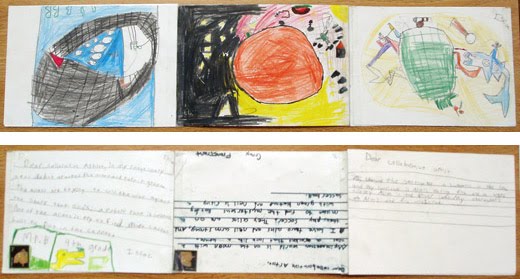For this lesson, I wanted to focus on creating artwork that tells a story. Fourth graders were introduced to collaborative art, and worked together by exchanging postcards between their classes. Using the elements of character, narrative and setting, their goal was to work collaboratively to create both a written and visual story with a beginning, middle and ending. In the past, I found there was a bit more excitement added to this lesson when postcards were exchanged with fourth grade classes at another school - so if any art teachers out there are interested for next time, let me know!
Beginning: Dear Collaborative Artist, My world is an ice cream world. It has a bunch of ice cream people driving around the city. The characters are made of ice cream and the cares are too. They are driving around in their cars and going back to their ice cream houses.
Middle: Dear Collaborative Artist, Your world is still ice cream but there are jobs, food, and ice cream police. The smoothies are homes. The ice cream police are drive cop cars.
Ending: The ice cream world now has a bunch of people driving around the city stopping at Lowes but there are cops in town now and a bunch of new hotels and smoothies!
Beginning: Dear Collaborative Artist, The name of my world is Goopa. It is a very weird planet. The characters are an alien and a robot. The robot is very strong and the alien is athletic. The robot and the alien are having a war. They are fighting over their worlds. Whoever wins gets the other person's land.
Middle: Dear Artist, Now they are in a duel and the robot is winning because he shot the other man's machine and shot his leg so he can't move and win.
Ending: The robot and the alien have agreed to share the land and stop the war instead of vaporizing each other.
Beginning: Dear Collaborative Artist, My imaginary world is on the moon with two aliens and a rocket that looks like a house. I have two aliens, Neil Armstrong, and they play soccer. The aliens are on a mission to find the mysterious hot dog with green ketchup and Neil is riding a soccer ball.
Middle: Dear Collaborative Artist, I changed the story to a summer in the sea and my narrative is aliens eating fish and a very crazy alien is in the driver seat.
Ending: In my imaginary world, robots attacked the man and turned it green. The aliens are trying to win the war against the shark.































